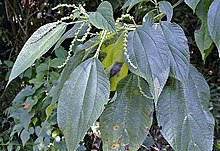Hypanartia lethe
| Hypanartia lethe | ||||||||||||
|---|---|---|---|---|---|---|---|---|---|---|---|---|

Hypanartia lethe |
||||||||||||
| Systematics | ||||||||||||
|
||||||||||||
| Scientific name | ||||||||||||
| Hypanartia lethe | ||||||||||||
| ( Fabricius , 1793) |
Hypanartia lethe is occurring in Central and South America butterfly ( butterfly ) from the family of Nymphalidae (Nymphalidae).
features
butterfly
The wingspan of the moth is 40 to 50 millimeters. There is no sexual dimorphism . In both sexes, the upper wing base color is orange to brown. The apex area of the forewings is black and mixed with a few yellowish, sometimes whitish spots. The diskal region is colored yellow and black. A double black line extends along the edge of the upper side of the hind wing. The hind wings are provided with short, pointed tails. The alternating yellow and brown undersides of the wings show a net-like pattern of several thin black transverse lines and stripes that resembles a road map . In English usage the species is referred to as Orange Mapwing (orange colored map), Orange Admiral (Orange Admiral) and sometimes as Small Brown Shoemaker (Little Brown Shoemaker).
Pre-imaginal stages
The white eggs are laid individually on the leaves of the food plant. Young caterpillars are initially colored black and have short thorns. They live in a rolled sheet that is lined with silk. The adult caterpillar is cream-colored, has an orange head and branched black thorns. During the feeding breaks she hides in a tent-like folded sheet that is spun with silk. The doll is designed as a falling doll, has a green color, several cone-like points on the abdomen and shows two short horns on the head.
Similar species
Similar moths of the genus Hypanartia , for example Hypanartia bella and Hypanartia godmanii, differ in their different line drawings on the underside of the wing.
distribution and habitat
Hypanartia lethe occurs in Mexico , Peru , Venezuela , Trinidad , Paraguay , Uruguay , Bolivia , in the south of Brazil and in the north of Argentina . Sometimes the moths migrate north to Texas , but do not reproduce there. The species is not native to Europe. With two records from Great Britain it can be assumed that the animals were brought in with imported products. The species primarily inhabits forests at altitudes between 300 and 1700 meters.
Way of life
The moths fly in several generations throughout the year, mainly in the months of April and July to October. They like to visit damp places in the earth, excrement or rotting fruit in order to absorb fluids and minerals. The caterpillars feed on the leaves of the Boehmeria caudata, which belong to the plant family of the nettle family (Urticaceae) . Other food plants mentioned are: Phenax , hackberry ( Celtis ) and Trema species.
Individual evidence
- ↑ Jeneice Clarke: The Online Guide to the Animals of Trinidad and Tobago , 2016 ( https://sta.uwi.edu/fst/lifesciences/sites/default/files/lifesciences/documents/ogatt/Hypanartia_lethe%20-%20Orange% 20Mapwing.pdf )
- ↑ a b Markku Savela: Hypanartia Hübner, [1821] - distribution. In: Lepidoptera and some other life forms. Retrieved May 2, 2019 .
- ↑ Small Brown Shoemaker at UK Butterflies
- ^ Butterflies of the Amazon and Andes, Orange Admiral
- ↑ flight times
- ↑ James A. Scott: The butterflies of North America. Stanford University Press, Stanford, California 1986, ISBN 0-8047-1205-0 , p. 280
literature
James A. Scott: The butterflies of North America. Stanford University Press, Stanford, California 1986, ISBN 0-8047-1205-0 , p. 280
Web links
- butterfliesofamerica - Butterflies of America
- discoverlife - Orange Mapwing at Discover Life

